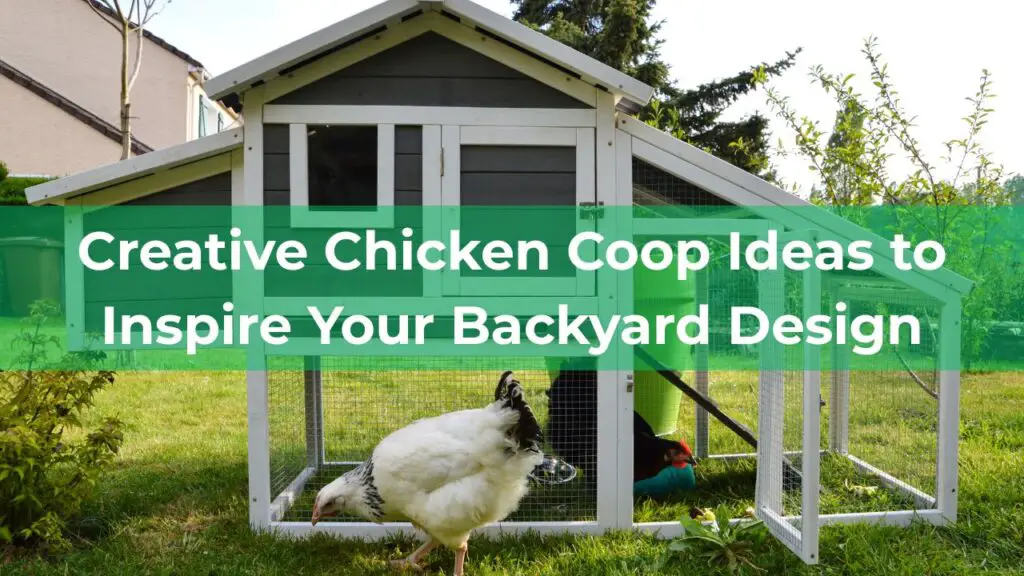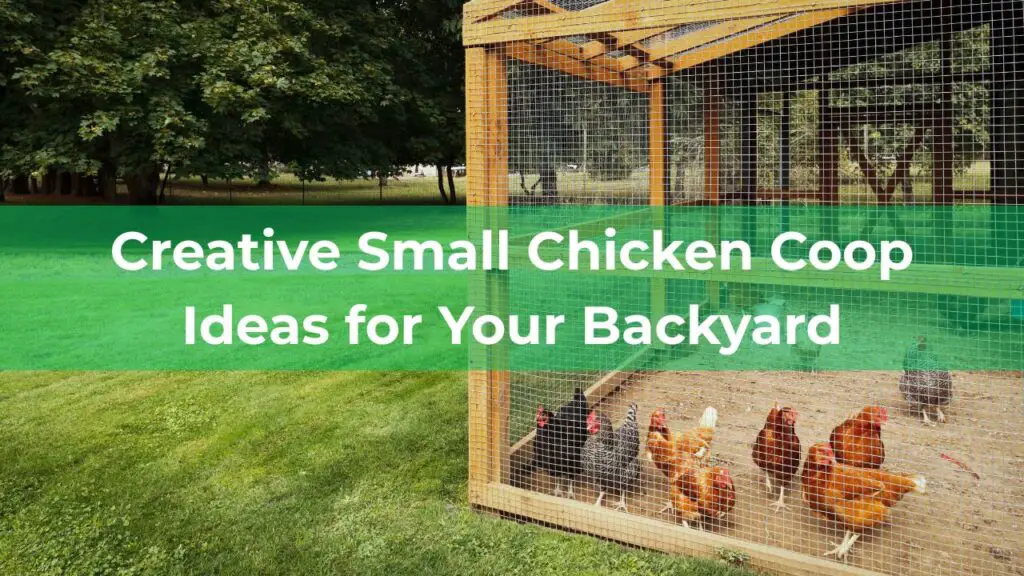Cottage garden design is all about creating a charming, cozy space that bursts with flowers, herbs, and lush greenery. This style embraces a casual, free-spirited aesthetic where plants are allowed to mingle and grow in seemingly delightful chaos. It’s perfect for those looking to add a touch of whimsy and natural beauty to their outdoor areas, making gardens feel inviting and lived-in.
Adding Whimsical Garden Furniture
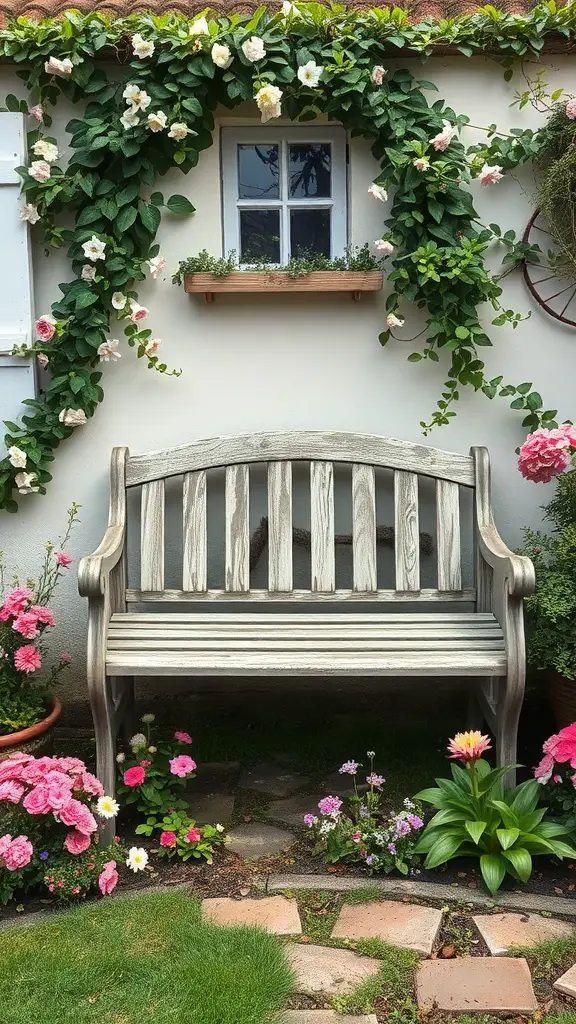
When designing a cottage garden, whimsical furniture can make a big difference. A charming bench, like the one in the image, invites you to sit and enjoy the beauty around you. Its rustic look blends perfectly with the vibrant flowers and greenery.
Surrounded by colorful blooms, this bench creates a cozy spot for relaxation. The flowers in shades of pink and white add a cheerful touch, making the space feel inviting. You can picture yourself sipping tea or reading a book here, surrounded by nature.
Choosing furniture that complements your garden’s style is key. Look for pieces that are not only functional but also add character. A wooden bench, like this one, can serve as a focal point while providing a comfortable place to unwind.
Incorporating playful elements, such as quirky garden sculptures or colorful cushions, can enhance the whimsical feel. These touches can make your garden feel like a magical retreat, perfect for enjoying sunny days.
Selecting a Color Palette for Seasonal Blooms
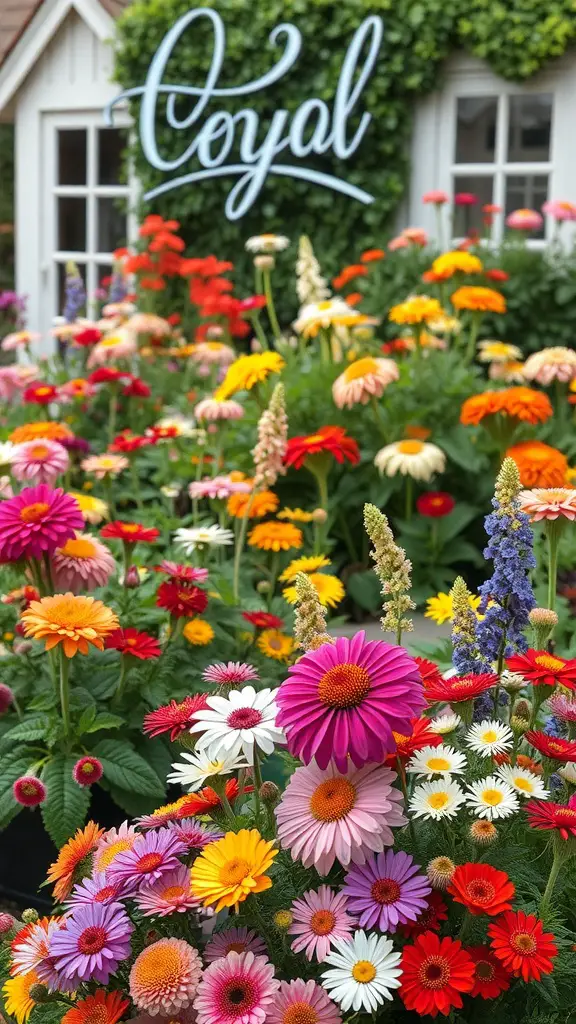
Choosing a color palette for your cottage garden can be a fun and rewarding task. The image showcases a vibrant mix of flowers, bursting with colors like pink, orange, yellow, and white. This lively display can inspire your own garden design.
When selecting colors, think about the mood you want to create. Bright colors like red and yellow bring energy, while softer shades like lavender and pale pink offer a calming effect. Mixing these can create a beautiful balance.
Consider the seasons too. In spring, pastel colors can shine, while summer might call for bolder hues. The flowers in the image show how seasonal blooms can complement each other, creating a harmonious look throughout the year.
Don’t forget about foliage! Green leaves can enhance the colors of your flowers, making them pop. The lush greenery in the background of the image highlights the colorful blooms beautifully.
Utilizing Edging for Defined Garden Beds
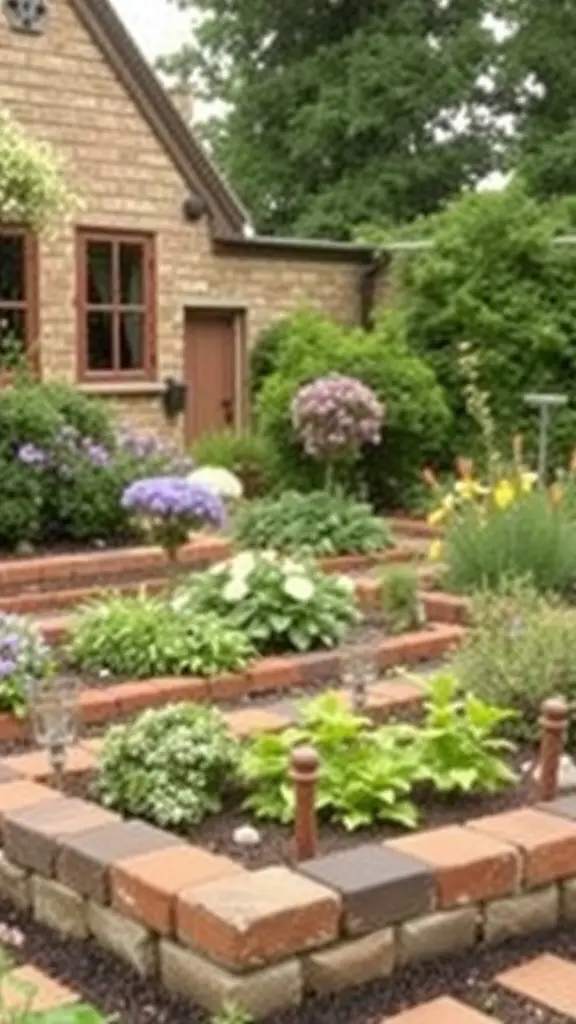
Edging is a simple yet effective way to create defined garden beds. In the image, you can see how the use of bricks outlines the garden areas, giving them a neat and tidy appearance. This not only enhances the visual appeal but also helps keep the soil and plants contained.
The different colors of the bricks add a charming touch, complementing the vibrant flowers and greenery. This contrast makes the garden feel more organized and inviting. Plus, it helps prevent grass and weeds from creeping into your flower beds, making maintenance a bit easier.
Using edging materials like bricks, stones, or even wood can help you achieve a rustic cottage garden look. It’s a great way to frame your plants and create a sense of structure. Whether you prefer a straight line or a more curved design, edging can adapt to your style.
So, if you’re looking to spruce up your garden, consider adding some edging. It’s a small change that can make a big difference in how your garden looks and feels!
Incorporating Vertical Elements with Trellises
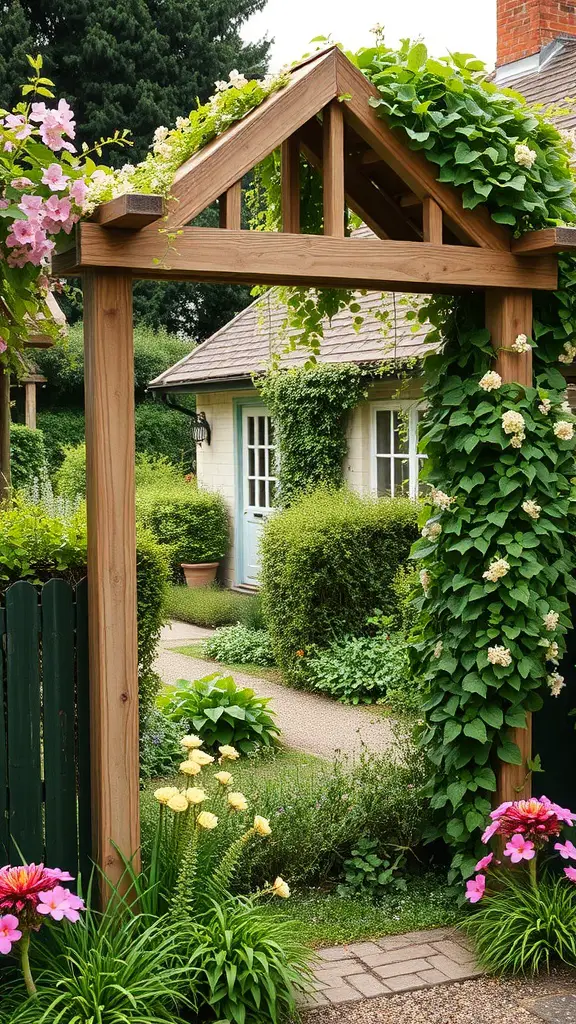
Trellises are a fantastic way to add vertical interest to your cottage garden. They create a beautiful frame for climbing plants and flowers, drawing the eye upward and adding depth to your garden design.
The image shows a lovely wooden trellis adorned with vibrant climbing plants. The greenery and flowers create a welcoming entrance, inviting visitors to explore the garden further. This setup not only enhances the aesthetic but also provides support for plants that thrive when they can climb.
Using trellises can also help define spaces within your garden. They can act as natural dividers, creating cozy nooks or pathways. Consider placing a trellis near a seating area to add a touch of charm and privacy.
When choosing plants for your trellis, think about color and bloom time. Mixing different varieties can create a stunning display throughout the seasons. Whether you prefer fragrant blooms or lush green foliage, there’s a climbing plant to suit every taste.
Incorporating Water Features for Serenity
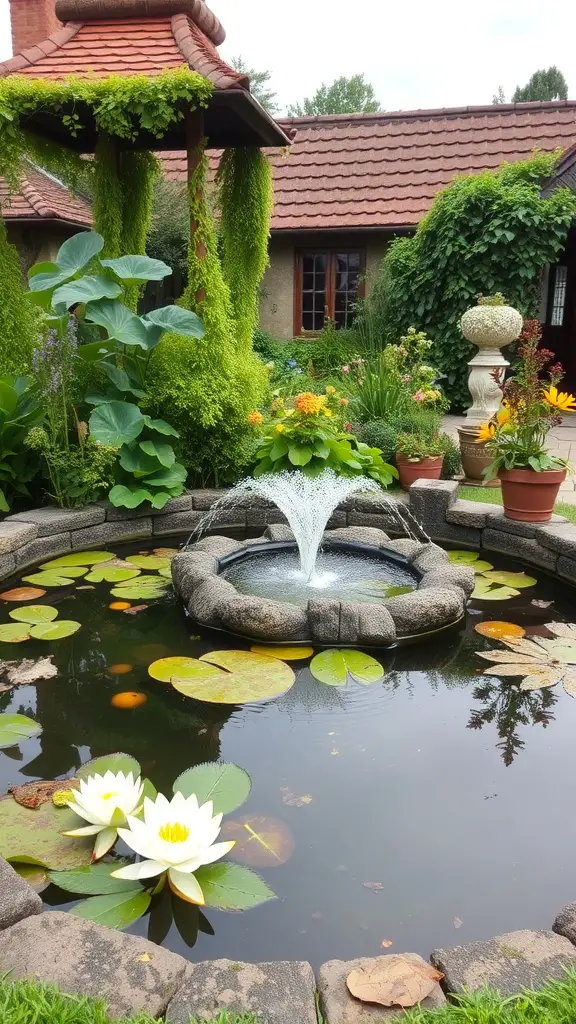
Water features can add a peaceful touch to your cottage garden. Imagine a small pond with a gentle fountain, like the one in the image. The sound of water trickling creates a calming atmosphere, perfect for relaxation.
This pond is surrounded by lush greenery and vibrant flowers, enhancing its charm. The water lilies floating on the surface add a splash of color and beauty. Such elements invite butterflies and birds, making your garden lively.
Consider placing your water feature in a spot where you can enjoy it from your favorite seating area. This way, you can unwind while listening to the soothing sounds of water. A well-placed fountain can also serve as a focal point, drawing the eye and adding interest to your garden design.
Creating Cozy Pathways with Gravel and Stone
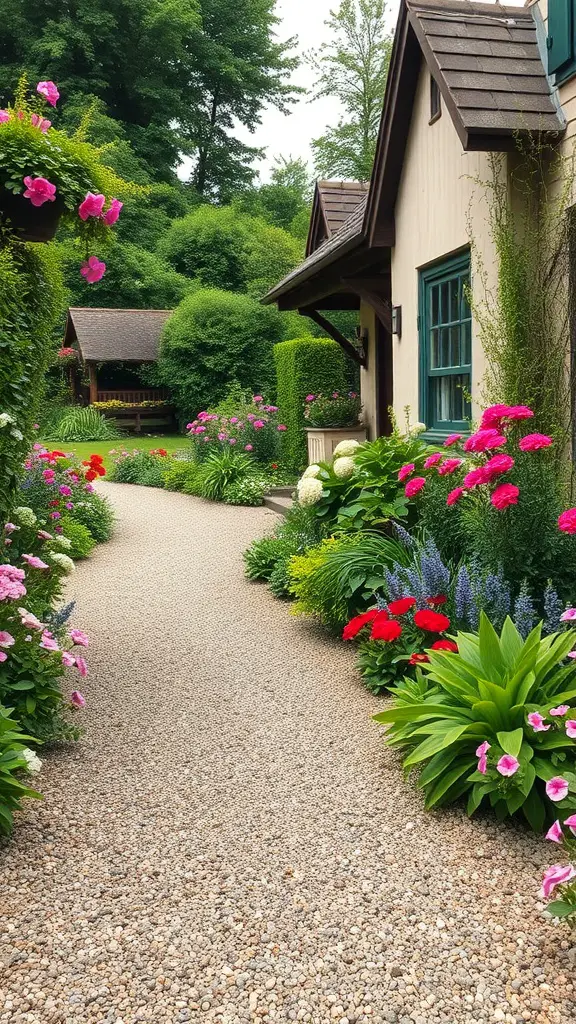
Pathways are essential in a cottage garden, guiding visitors through the beauty of nature. A gravel path, like the one shown, offers a rustic charm that perfectly complements vibrant flowers and lush greenery.
The soft colors of the flowers, from pinks to reds, contrast beautifully with the earthy tones of the gravel. This combination creates a welcoming atmosphere that invites you to stroll through the garden.
Gravel is not just practical; it’s also low maintenance. It allows for good drainage, keeping the path dry and accessible. Plus, the crunch of gravel underfoot adds a delightful sensory element to your garden experience.
When designing your pathway, consider the shape. A gentle curve, as seen here, can make the garden feel more inviting and less formal. It encourages exploration, leading to hidden corners and surprises.
Incorporating stone elements, like edging or decorative features, can enhance the overall look. These details add texture and interest, making the pathway a focal point in your garden design.
The Art of Layering Plants for Depth
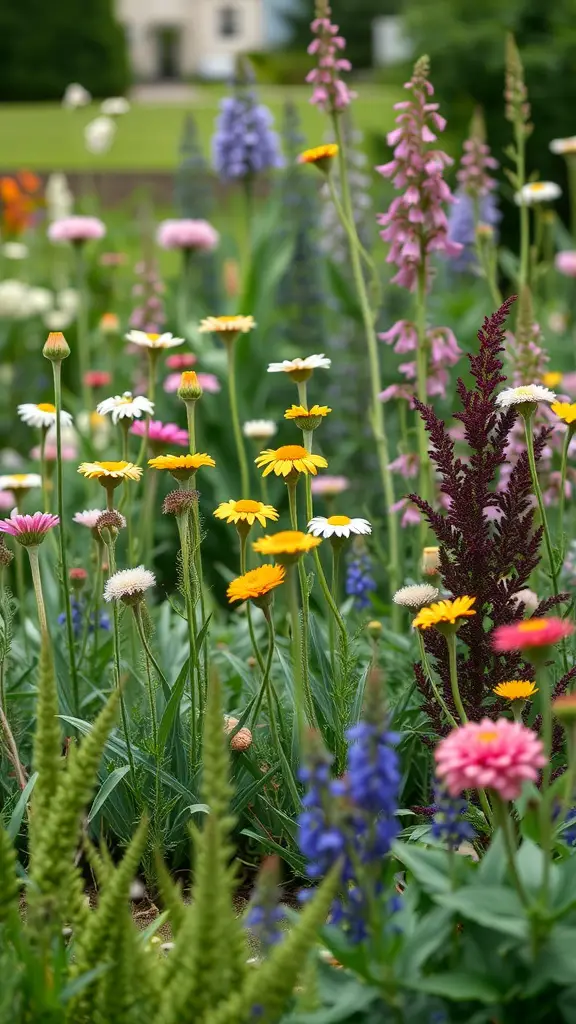
Layering plants is a key technique in cottage garden design. It creates a sense of depth and fullness that draws the eye. In the image, you can see a delightful mix of flowers at different heights, which adds visual interest.
Notice how the taller flowers, like the pink and purple spikes, stand proudly in the background. They provide a beautiful backdrop for the shorter blooms in the foreground, such as the cheerful yellow and white daisies. This arrangement not only looks appealing but also helps each plant shine.
Mixing colors and textures is essential too. The vibrant yellows, pinks, and blues create a lively scene. The variety of shapes, from the delicate petals of daisies to the bold spikes of other flowers, adds to the charm. This layering technique invites exploration, making you want to wander through the garden.
When planning your own cottage garden, think about how you can layer plants to create a similar effect. Choose a mix of heights and colors to keep things exciting. The goal is to create a space that feels lush and inviting, just like the one in the image.
Choosing the Right Plants for a Cottage Garden
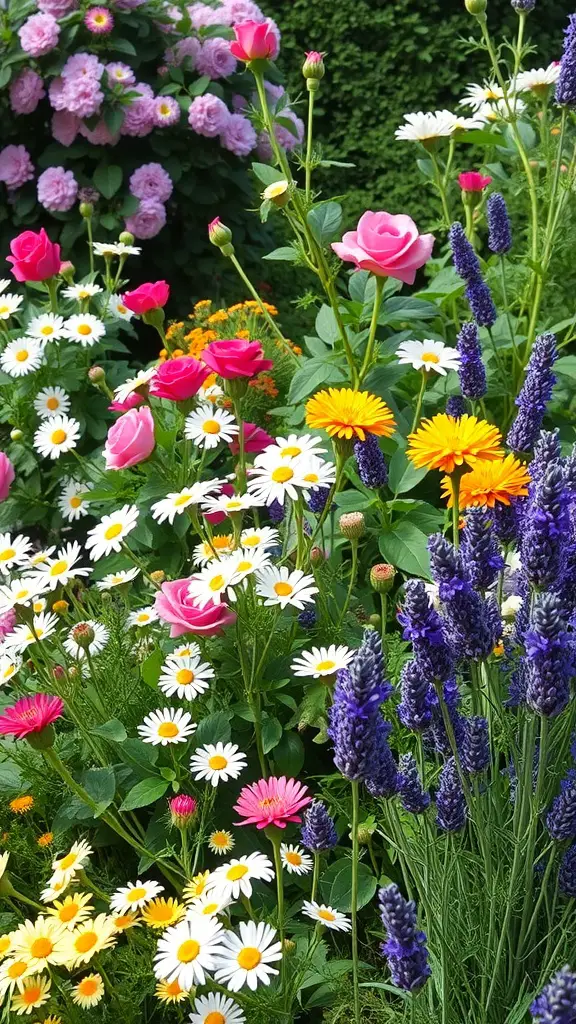
A cottage garden is a delightful blend of colors, textures, and scents. The image showcases a vibrant array of flowers, including roses, daisies, and lavender, all thriving together. This mix creates a cheerful and inviting atmosphere, perfect for any garden lover.
When selecting plants for your cottage garden, think about variety. Incorporating different types of flowers, like the cheerful daisies and fragrant lavender seen here, can add depth and interest. Choose plants that bloom at various times to keep your garden lively throughout the seasons.
Don’t forget about height and layering. Taller plants, like the lavender, can provide a beautiful backdrop for shorter blooms. This layering creates a lush, full look that feels natural and welcoming. Aim for a mix of perennials and annuals to ensure your garden remains vibrant year after year.
Finally, consider the colors. The image highlights a lovely palette of pinks, yellows, and whites. These colors work well together and can evoke a sense of warmth and joy. Feel free to experiment with your own color combinations to make your cottage garden uniquely yours!
Employing Natural Fencing for Privacy
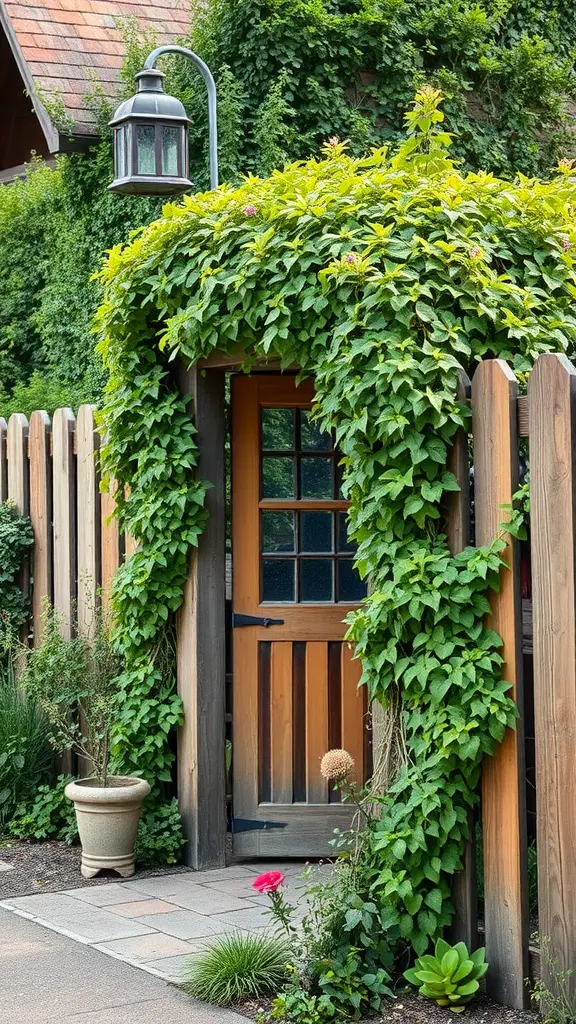
Creating a cozy cottage garden often involves finding ways to ensure privacy. Natural fencing is a fantastic option that blends seamlessly with the garden’s charm. In the image, we see a lovely wooden gate framed by lush greenery. This setup not only provides a sense of seclusion but also enhances the garden’s aesthetic.
The climbing plants around the entrance create a welcoming feel. They soften the hard lines of the wooden fence and add a touch of nature. This type of fencing can be both functional and beautiful, allowing you to enjoy your outdoor space without feeling exposed.
Incorporating plants like vines or flowering shrubs can make your garden feel more intimate. They can grow over fences or gates, creating a natural barrier that feels alive. This approach is not just about privacy; it also invites wildlife and adds color to your garden.
Consider using a mix of plants that bloom at different times to keep your garden vibrant year-round. With the right choices, you can create a stunning natural fence that complements your cottage garden design beautifully.
Creating a Relaxing Seating Area
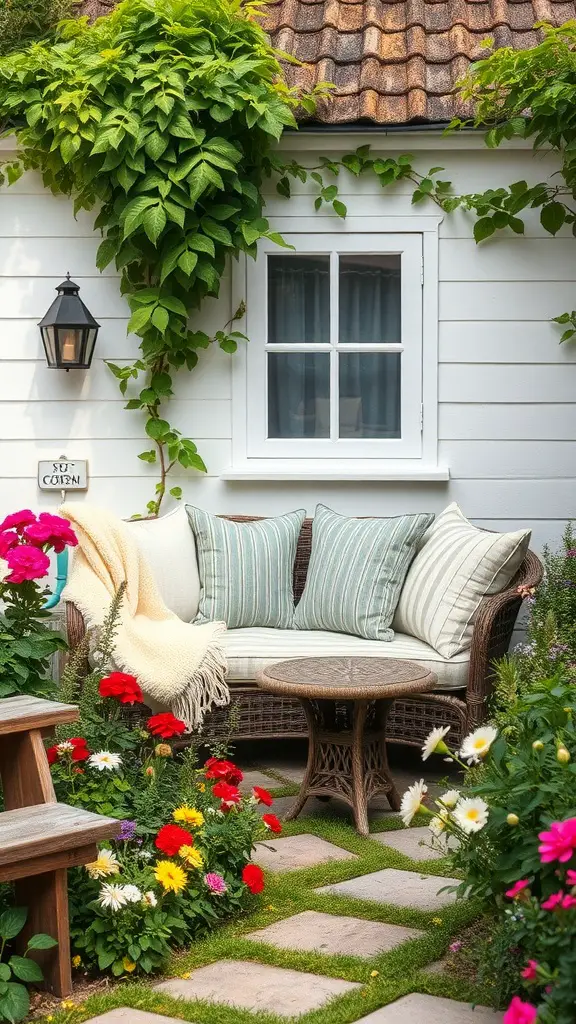
A cozy seating area can transform your cottage garden into a peaceful retreat. Picture a comfortable sofa, adorned with soft cushions and a warm throw, inviting you to sit back and unwind. This setup not only enhances the garden’s charm but also offers a perfect spot to enjoy nature.
Surrounding the seating with colorful flowers adds a lively touch. Bright reds, yellows, and whites create a cheerful atmosphere. The pathway, lined with stone pavers and lush greenery, guides you to this inviting nook. It’s a great way to connect with the beauty of your garden.
Consider adding a small table for your favorite drink or a book. This little detail makes the space even more functional. A lantern on the wall provides soft lighting for those evening moments, making it a lovely spot to relax as the sun sets.
Incorporating Seasonal Decorations
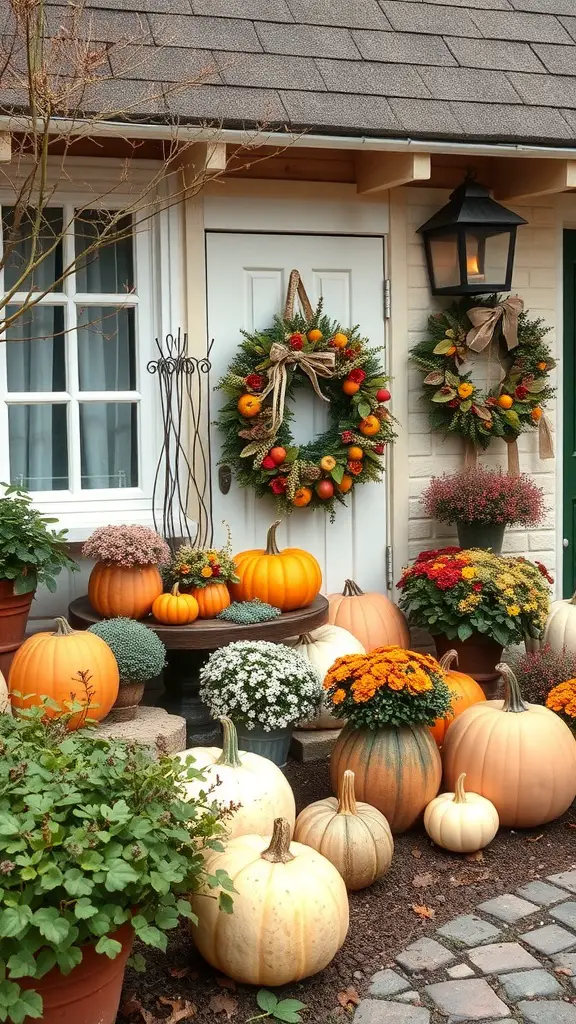
Seasonal decorations can bring a cottage garden to life, adding charm and warmth. Imagine a cozy entrance adorned with vibrant pumpkins and cheerful wreaths. The image shows a delightful display of pumpkins in various sizes, nestled among colorful flowers and greenery.
Wreaths made from natural elements hang on the door, inviting guests with their festive flair. These decorations not only celebrate the season but also create a welcoming atmosphere. A mix of textures and colors, like the soft hues of the pumpkins and the bright blooms, adds visual interest.
Using seasonal items like pumpkins and flowers can be a fun way to change the look of your garden. You can switch things up with each season, keeping your space feeling fresh and inviting. Think about adding different plants or decorations that reflect the time of year, making your cottage garden a year-round delight.
Designing with Seasonal Interest in Mind
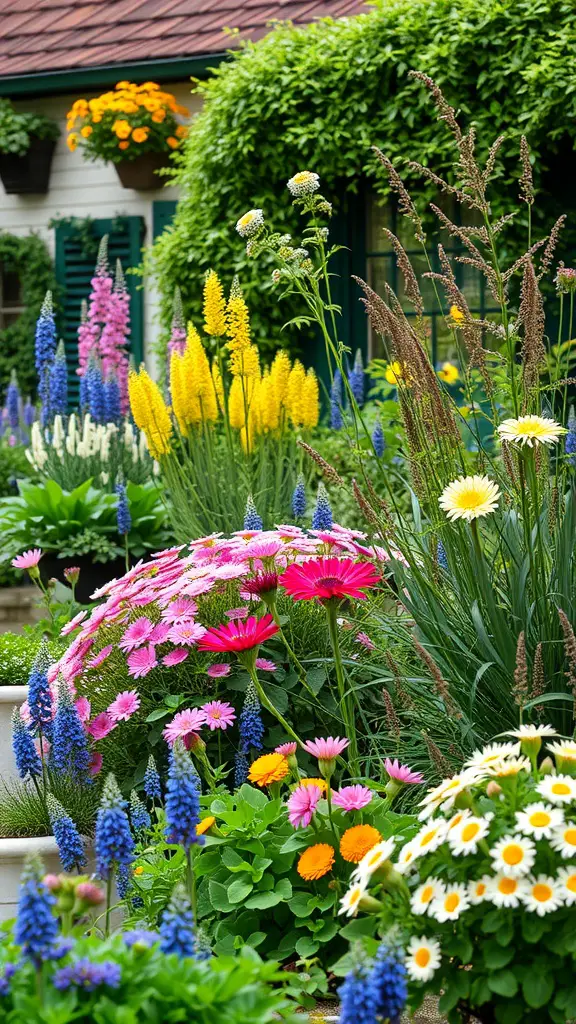
A cottage garden thrives on variety and color, making it a delightful space throughout the seasons. The image shows a vibrant mix of flowers, including pink daisies, yellow spikes, and blue blossoms. This colorful display not only catches the eye but also invites pollinators, enriching the garden’s ecosystem.
When designing your cottage garden, think about how different plants bloom at various times of the year. By selecting a range of flowers that bloom in spring, summer, and fall, you can ensure that your garden remains lively and appealing. For instance, early bloomers like daffodils can be paired with summer favorites like geraniums.
Incorporating plants with varying heights adds depth and interest. Taller flowers can create a backdrop, while shorter ones fill in the foreground. This layering effect enhances the overall look and keeps the garden dynamic. Don’t forget to include some evergreen plants for winter interest, too!
Using seasonal plants allows for a changing landscape. Each season brings its own charm, from the fresh greens of spring to the warm hues of autumn. This approach not only beautifies your space but also keeps gardening exciting as you plan for each new season.
Incorporating Aromatic Herbs for Practicality
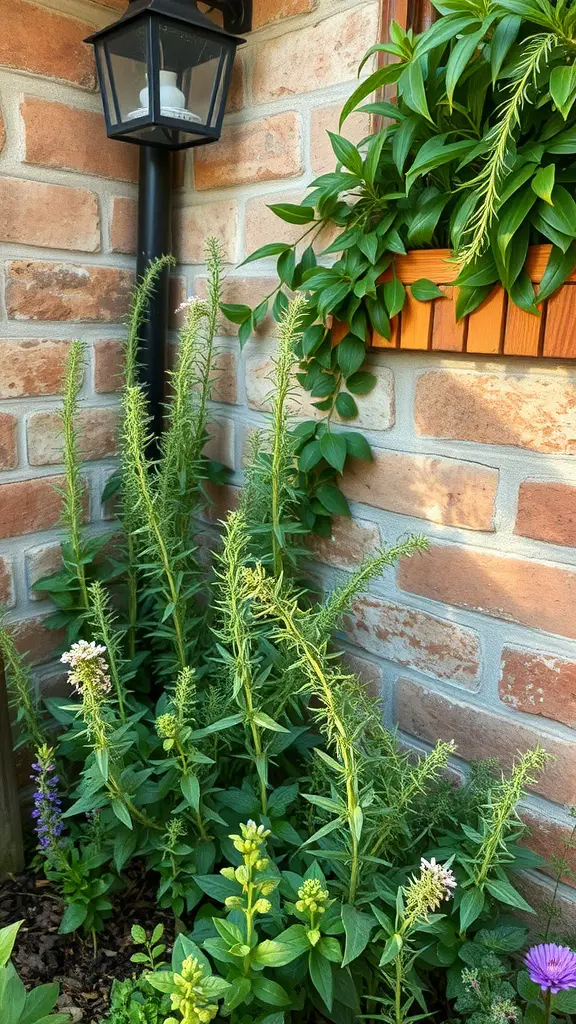
A cottage garden thrives on charm and practicality, and aromatic herbs play a key role in this balance. The image shows a lovely corner of a garden, where various herbs are growing alongside a warm brick wall. This setup not only adds beauty but also serves a practical purpose.
Herbs like thyme, mint, and basil can be seen, bringing delightful scents and flavors to your kitchen. They are easy to grow and require minimal care, making them perfect for any gardener. Imagine stepping outside to snip fresh herbs for your meals!
Incorporating these herbs into your garden design can also attract beneficial insects, which help with pollination. The mix of greenery and blooms creates a vibrant atmosphere, enhancing the overall appeal of your cottage garden.
Don’t forget to consider the placement of your herbs. A sunny spot near your kitchen door makes it easy to grab what you need while cooking. This practical approach keeps your garden functional and beautiful.
Using Containers for Versatile Planting
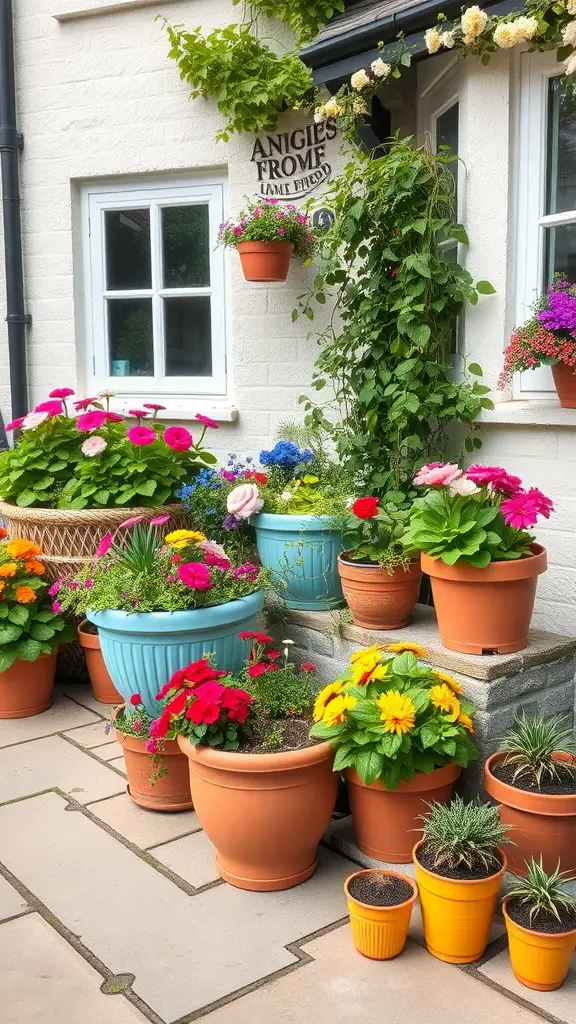
Container gardening is a fantastic way to bring life to any space, especially in a cottage garden. The image shows a charming setup with colorful pots filled with vibrant flowers. Each container adds a unique touch, making the area feel welcoming and lively.
Using containers allows for flexibility in your garden design. You can easily rearrange them to suit your mood or the season. The variety of colors and shapes in the pots creates a playful atmosphere. It’s a great way to experiment with different plants without committing to a permanent spot in the garden.
Another benefit is that containers can fit into smaller spaces. If you have a patio or balcony, you can still enjoy the beauty of flowers. The image highlights how even a few pots can transform a simple entryway into a delightful display.
Don’t forget about the practical side! Containers can help manage soil quality and drainage, making it easier to care for your plants. You can choose the right soil mix for each type of plant, ensuring they thrive. Plus, they can be moved to catch the best sunlight or shade as needed.
Creating a Wildlife-Friendly Environment
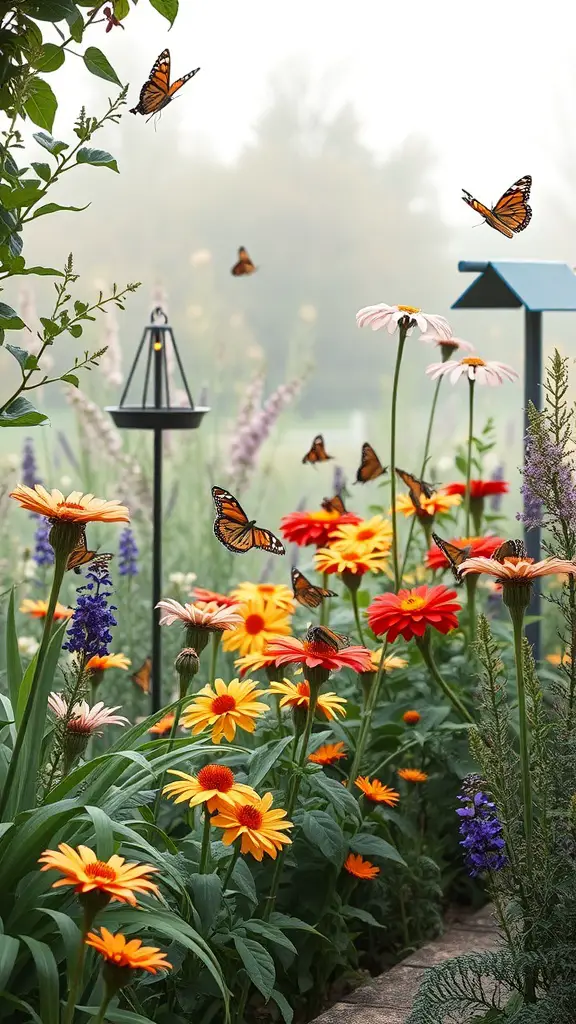
A cottage garden is not just a feast for the eyes; it can also be a welcoming space for wildlife. The image showcases a vibrant array of flowers, with butterflies fluttering about, creating a lively scene. This garden design encourages a diverse ecosystem, making it a perfect spot for various creatures to thrive.
To attract butterflies, consider planting native flowers like coneflowers and daisies. These plants provide nectar, which is essential for butterflies. The colorful blooms in the image highlight how a mix of flowers can create a beautiful and functional garden.
Adding bird feeders and baths can also enhance your garden’s appeal to wildlife. The lanterns in the image suggest a cozy atmosphere, perfect for evening visits from nocturnal creatures. A wildlife-friendly garden not only supports local fauna but also brings joy to those who enjoy watching them.
Incorporating native plants is key. They require less maintenance and provide the right habitat for local wildlife. The lush greenery and colorful flowers in the image demonstrate how a well-planned garden can be both stunning and supportive of nature.
Using Mulch to Retain Moisture and Suppress Weeds
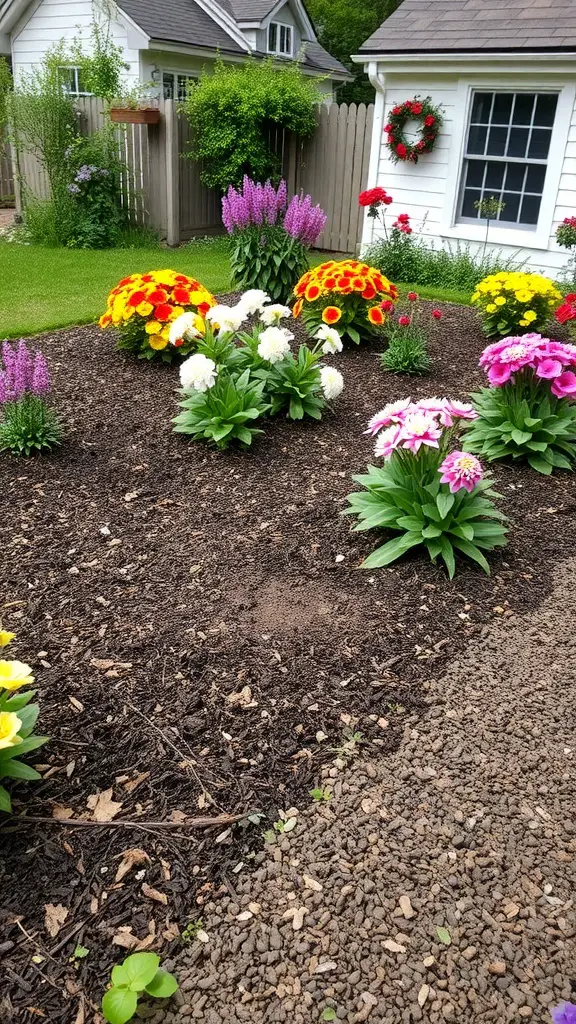
Mulch is a gardener’s best friend, especially in a cottage garden. In the image, you can see a vibrant display of flowers surrounded by a fresh layer of mulch. This dark, rich material not only looks great but also serves several important purposes.
One of the main benefits of using mulch is moisture retention. When you spread mulch around your plants, it helps keep the soil moist. This is especially helpful during hot summer days when plants can easily dry out. The mulch acts like a blanket, reducing evaporation and keeping the roots happy.
Another great thing about mulch is its ability to suppress weeds. Weeds can be a real nuisance, stealing nutrients and water from your flowers. A thick layer of mulch makes it harder for weeds to grow, giving your plants a better chance to thrive. In the image, the colorful flowers are clearly thriving, thanks in part to the protective layer of mulch around them.
Choosing the right type of mulch is key. Organic options like wood chips or straw break down over time, enriching the soil. Inorganic mulches, like stones or rubber, last longer but don’t add nutrients. Either way, adding mulch to your garden is a simple step that pays off in a big way.
Combining Modern Elements with Traditional Styles

In this charming cottage garden, the blend of modern and traditional elements creates a delightful space. The path made of stone slabs leads the way to a cozy entrance, inviting you to explore further. Brightly colored flowers, like pink petunias and cheerful sunflowers, add a lively touch, while the neatly arranged potted plants bring a contemporary vibe.
The two small tables with white tops offer a perfect spot for enjoying a cup of tea. They contrast beautifully with the vibrant flowers, merging functionality with style. This garden showcases how modern design can harmonize with classic aesthetics, making it a welcoming retreat.
Surrounding greenery adds depth and texture, enhancing the overall appeal. The combination of colors and shapes makes this garden a feast for the eyes. It’s a perfect example of how to create a space that feels both fresh and timeless.
Utilizing Natural Pathway Materials
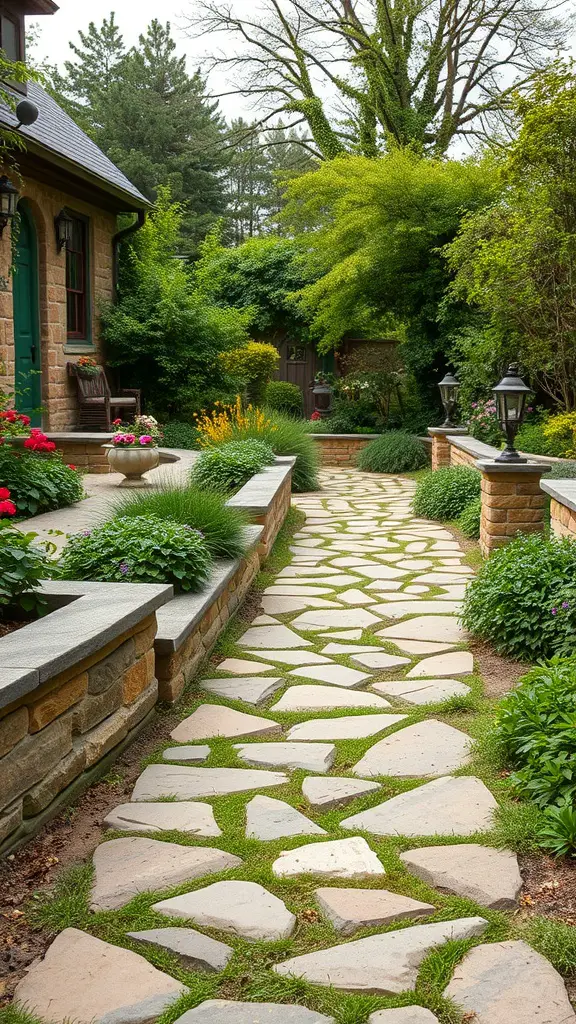
Creating a charming cottage garden often starts with the pathways that guide you through the space. The image showcases a beautiful stone pathway, perfectly blending with the surrounding greenery. This natural look enhances the garden’s overall appeal.
The stones are irregularly shaped, giving the pathway a relaxed and organic feel. This style invites you to wander and explore, making it a great choice for a cottage garden. The gaps filled with lush grass add a touch of softness and help the pathway feel like a part of nature.
Choosing natural materials like stone not only looks good but also supports sustainability. They are durable and can withstand the elements, making them a smart choice for outdoor spaces. Plus, they can be sourced locally, reducing your carbon footprint.
When planning your pathway, think about how it connects different areas of your garden. A winding path can create a sense of discovery, leading visitors from one delightful spot to another. The stones in this image are complemented by vibrant flowers and greenery, making every step a visual treat.
Creating a Focal Point with a Sculpture or Birdbath
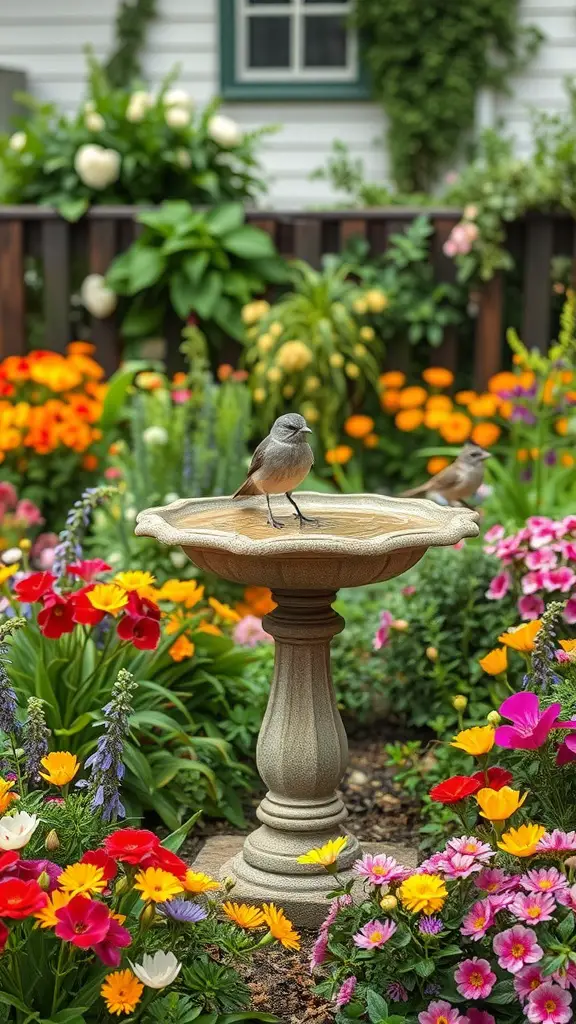
A cottage garden thrives on charm and character. One of the best ways to create a focal point is by adding a sculpture or a birdbath. These elements draw the eye and invite curiosity. In the image, a lovely birdbath stands proudly among vibrant flowers, creating a delightful scene.
The birdbath not only serves as a decorative piece but also attracts birds, adding life to your garden. Imagine the joy of watching birds splash and play in the water. This interaction with nature enhances the overall experience of your garden.
Choosing a birdbath that complements your garden style is key. Whether it’s a classic design or something more modern, it should blend seamlessly with the surrounding flowers. The colorful blooms in the image highlight how well a birdbath can fit into a lively garden setting.
Incorporating a sculpture can add a different dimension. It can be whimsical or elegant, depending on your taste. A sculpture can tell a story or simply add a touch of artistry. Position it where it can be easily seen, allowing it to become a conversation starter.
Ultimately, a focal point like a birdbath or sculpture enhances the beauty of your cottage garden. It creates a space that feels inviting and full of life.
Designing a Cottage Garden for Small Spaces
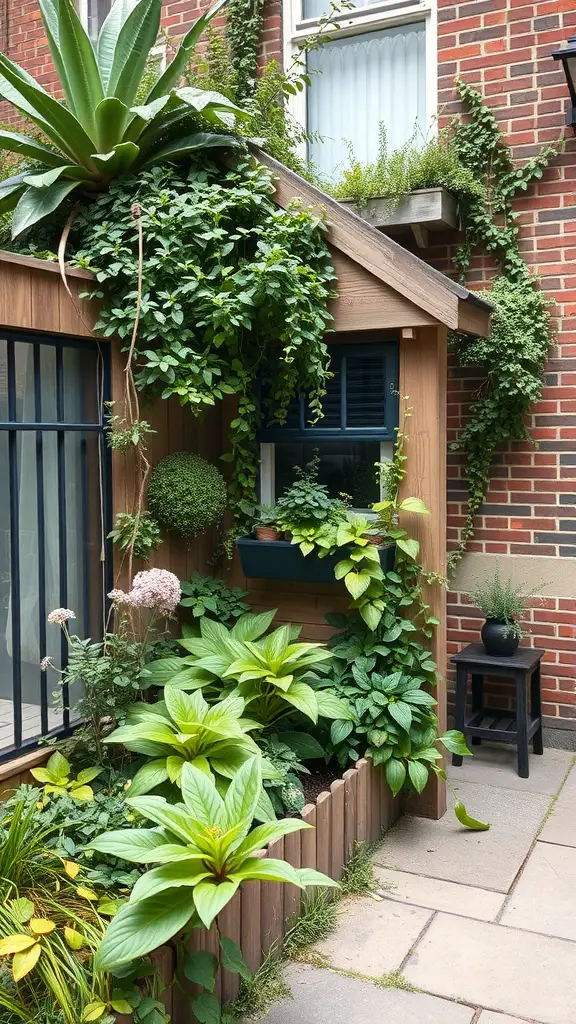
A cottage garden can be a delightful addition to any small space. This image shows a charming setup that perfectly captures the essence of such a garden. The lush greenery and thoughtful arrangement create a cozy atmosphere.
Notice the variety of plants. They add texture and interest, making the garden feel alive. The use of vertical space is clever, with plants climbing the walls and spilling over the edges. This is a great way to maximize limited areas.
The wooden fence not only defines the space but also adds a rustic touch. It complements the natural elements beautifully. A small seating area, like the black stool shown, invites relaxation and enjoyment of the surroundings.
When designing your own cottage garden, think about layering plants. Taller ones can go at the back, while shorter varieties can fill in the front. This creates depth and draws the eye. Incorporating different shades of green, along with pops of color from flowers, can enhance the overall look.
Don’t forget about containers! They can be placed on walls or in corners to add more greenery without taking up too much space. This image is a great reminder that even small areas can be transformed into a lovely garden retreat.
Incorporating Seasonal Veggies into the Design
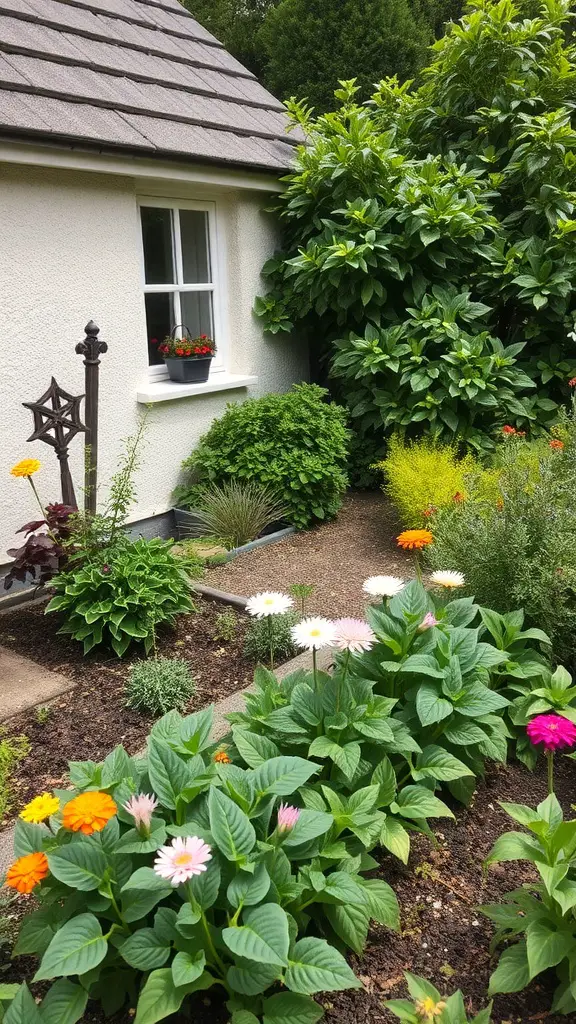
Creating a cottage garden is a delightful way to blend beauty with functionality. The image shows a charming garden space filled with vibrant flowers and lush greenery. This setting is perfect for adding seasonal vegetables, making the garden not only pretty but also productive.
When planning your garden, think about where to place your veggies. You can mix them in with your flowers or dedicate a specific area for them. For instance, colorful zinnias and cheerful marigolds can coexist with tomatoes and peppers. This combination adds visual interest while maximizing space.
Consider planting vegetables that thrive in your local climate. Herbs like basil and parsley can be great companions for many flowers. They not only enhance the garden’s look but also provide fresh ingredients for your kitchen. Plus, they attract beneficial insects!
Seasonal veggies like lettuce, radishes, and carrots are easy to grow and can be planted in succession for a continuous harvest. Imagine stepping outside to pick fresh salad ingredients right from your garden. It’s a simple pleasure that adds to the charm of cottage gardening.
Don’t forget to plan for maintenance. Regular watering and weeding will keep both your flowers and veggies healthy. With a little care, your cottage garden can be a beautiful and bountiful space all year round.
Planning for Maintenance and Sustainability
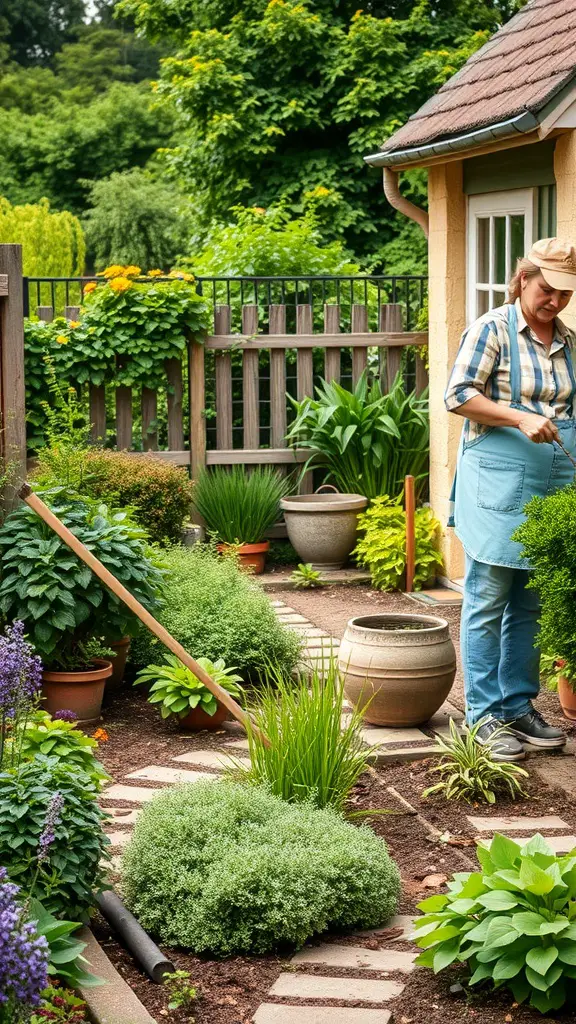
A cottage garden is a delightful blend of beauty and practicality. The image shows a gardener tending to a lush garden filled with various plants, creating a vibrant and inviting space. This type of garden often features a mix of flowers, herbs, and vegetables, making it both attractive and functional.
When planning for maintenance, it’s important to choose plants that thrive in your local climate. Native plants typically require less water and care, making them a smart choice for sustainability. Grouping plants with similar needs can also simplify watering and upkeep.
Mulching around plants helps retain moisture and suppress weeds. This not only reduces the time spent on maintenance but also supports the health of the garden. Regular pruning and deadheading will keep plants looking their best and encourage new growth.
Consider using organic methods for pest control. Natural solutions can protect your plants without harming the environment. Creating a balanced ecosystem in your garden will attract beneficial insects that help manage pests.
Lastly, think about water conservation. Installing a rain barrel can collect water for irrigation, making your garden more sustainable. A cottage garden should be a joyful space that requires thoughtful planning for long-term enjoyment.

